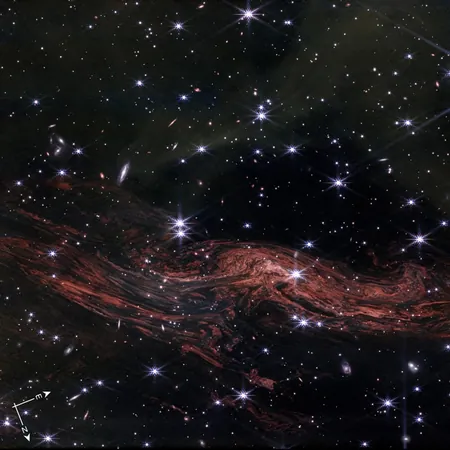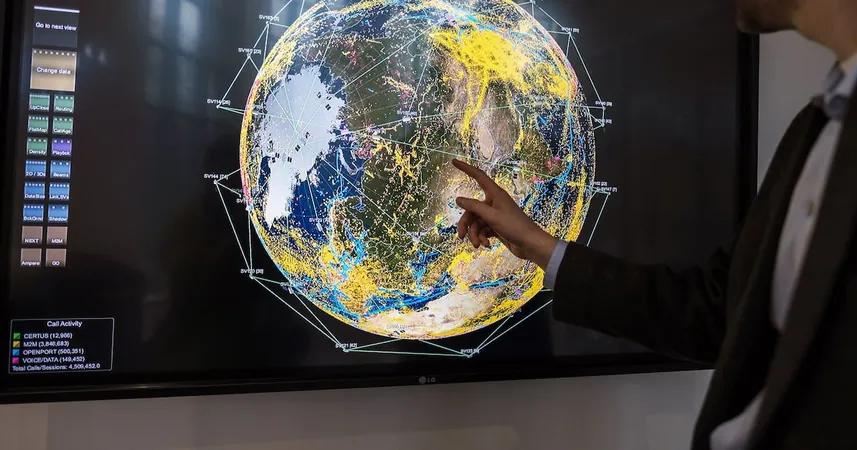
Exploring the Cosmic Connection: Distant Galaxy Mirrors Milky Way's Icy Dust
2025-06-12
Author: Emily
Dust might be an annoyance to us, but for astronomers, it’s a treasure trove of information. Recent observations from the James Webb Space Telescope (JWST) have unveiled fascinating insights about a distant galaxy, revealing that its icy dust could hold the key to understanding the formation of planets similar to those in our Solar System.
A Galaxy 5 Billion Light-Years Away
Meet SSTXFLS J172458.3+591545, a galaxy located a staggering 5 billion light-years away. This distance means we're observing it as it appeared when our Solar System was just beginning to take shape. The image painted by JWST showcases solid molecules of ice, such as carbon dioxide, carbon monoxide, and water ice, nestled within this galaxy's dust—remarkably akin to what we find in our own Milky Way.
Astronomer Anna Sajina from Tufts University notes, ‘If the properties of dust in distant galaxies mirror our own, the planets forming in these ancient heavens are likely crafted from the same cosmic ingredients.' What an exhilarating thought!
Unlocking the Mysteries of Dust
Sajina leads a team utilizing JWST to delve deep into SSTXFLS J172458.3+591545, concentrating on regions where dust shrouds the secrets of star and black hole formation—key players in the evolution of galaxies. While dust obscures our view, its composition can illuminate the very processes that shape the cosmos.
The Milky Way's dust hides its bustling center, a phenomena captured magnificently by NASA’s Spitzer Space Telescope, which illuminated the hidden dust clouds around young stars. Now, armed with JWST’s infrared spectrograph, astronomers can peer into the composition of these distant dust clouds.
The Challenge of Observing Cosmic Dust
Studying dust in far-off galaxies presents several challenges. For one, dust absorbs visible light, making it hard to detect even nearby. Traditional Earth-bound telescopes struggled with atmospheric interference until infrared-sensitive instruments took to the skies. Furthermore, the light from these distant galactic wonders is redshifted, pushing it further into the infrared spectrum where traditional observations become increasingly tricky.
Sajina's pioneering work breaks new ground, providing unparalleled spectral detail that reveals the chemical interactions occurring on the surfaces of cosmic dust grains.
Revelations from the Ice-Covered Dust
The icy dust discovered in SSTXFLS J172458.3+591545 indicates a rich region filled with dense gas and dust clumps, hinting at a compact nucleus likely hosting a supermassive black hole. Dust clumps can orbit these black holes, creating unique structures that offer indirect evidence of their existence.
This breakthrough marks the first-time astronomers have detected a combination of carbon dioxide, carbon monoxide, and other icy compounds in such a distant star-forming galaxy. It positions JWST’s capabilities as an invaluable resource for future explorations of dust across the cosmos and may provide fresh insights into the birth of stars and planets in distant galaxies.
A Glimpse into Cosmic History
As JWST continues to gaze into the depths of space, each finding brings us closer to understanding not just our own celestial neighborhood, but the rich tapestry of the universe’s history. Who knows what new revelations await as we venture further into the enigmatic realms of space and time?









 Brasil (PT)
Brasil (PT)
 Canada (EN)
Canada (EN)
 Chile (ES)
Chile (ES)
 Česko (CS)
Česko (CS)
 대한민국 (KO)
대한민국 (KO)
 España (ES)
España (ES)
 France (FR)
France (FR)
 Hong Kong (EN)
Hong Kong (EN)
 Italia (IT)
Italia (IT)
 日本 (JA)
日本 (JA)
 Magyarország (HU)
Magyarország (HU)
 Norge (NO)
Norge (NO)
 Polska (PL)
Polska (PL)
 Schweiz (DE)
Schweiz (DE)
 Singapore (EN)
Singapore (EN)
 Sverige (SV)
Sverige (SV)
 Suomi (FI)
Suomi (FI)
 Türkiye (TR)
Türkiye (TR)
 الإمارات العربية المتحدة (AR)
الإمارات العربية المتحدة (AR)